Blending vintage decor with modern design has become a popular trend in home styling. This approach not only adds unique character to your space but also offers a sustainable way to refresh your interiors. By incorporating thrifted pieces, you can create a look that’s both timeless and cost-effective.
Mixing eras and styles might seem challenging, but it’s all about balance. For instance, a farmhouse table from Habitat ReStore can serve as a stunning centerpiece in a contemporary dining room. The key is to curate pieces that tell a story, adding emotional depth to your home.
Creating a cohesive space with vintage elements doesn’t have to be overwhelming. Start small, focus on quality over quantity, and let each piece shine. The result? A personalized sanctuary that feels both nostalgic and fresh.
Key Takeaways
- Blending vintage and modern styles adds unique character to your space.
- Thrifted decor is a sustainable and budget-friendly option.
- Balance is key when mixing different eras and styles.
- Real-world examples, like farmhouse tables, can inspire your design.
- Curated spaces with vintage pieces offer emotional value and depth.
Introduction to Decorating with Vintage Finds
Exploring the charm of older items can transform your living area into a unique haven. These pieces, often rich in history, bring a sense of character and warmth to any space. Understanding the difference between vintage and antique classifications is key to curating a cohesive design.
In the design world, vintage items are typically 40+ years old, while antiques are 100+ years old. The quality of materials, such as solid wood versus modern particle board, often sets these finds apart. This distinction helps you make informed choices when adding older elements to your home.
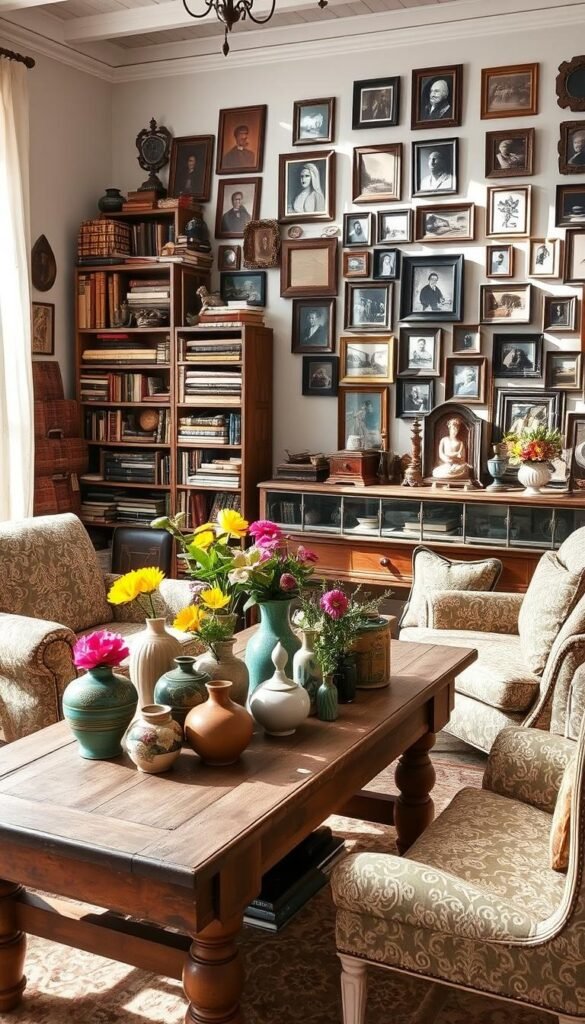
Recently, materials like milk glass and copper have made a comeback in contemporary tablescapes. Their timeless appeal pairs beautifully with modern accents, creating a balanced and inviting atmosphere. For inspiration, look to The Ponds Farmhouse, which masterfully blends rustic charm with sleek, modern touches.
Thrifting adventures are another exciting way to discover unique items. Regional examples, such as flea markets in the Midwest or estate sales in the South, offer a treasure trove of possibilities. These experiences not only add personality to your home but also support sustainable living.
Embracing older decor is more than just a trend—it’s a conscious choice to celebrate history and reduce waste. By integrating these elements, you create a space that’s both stylish and environmentally friendly.
| Category | Age | Key Characteristics |
|---|---|---|
| Vintage | 40+ years | Often features solid wood, unique craftsmanship, and retro designs. |
| Antique | 100+ years | Typically includes rare materials, intricate details, and historical significance. |
Why Choose Vintage Decor?
Incorporating older pieces into your home design brings a sense of history and personality. These items, often crafted with care, add a layer of warmth and uniqueness to modern spaces. With 72% of interior designers noting increased client demand for vintage pieces, it’s clear this trend is here to stay.
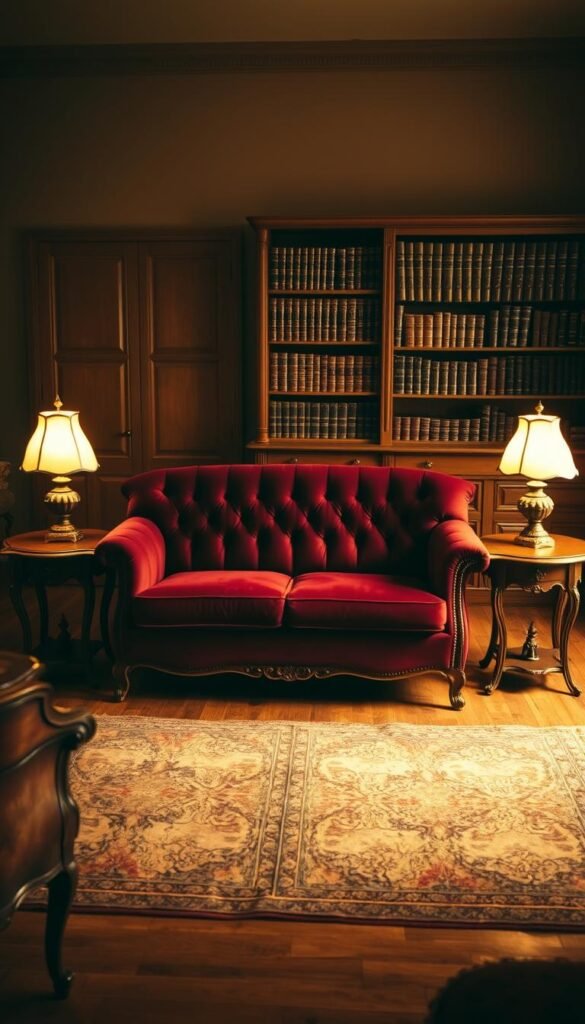
The Appeal of Vintage Decor
Older furnishings, like those from the 1920s, often feature solid wood construction—found in 89% of pre-1970s furniture. This contrasts sharply with modern equivalents, where only 23% use such durable materials. The craftsmanship of these pieces ensures they stand the test of time, making them a smart investment for your home.
Heirloom-quality textiles, such as handwoven rugs or embroidered linens, evoke nostalgia and add emotional depth. These items tell stories, creating a connection between past and present. A restored 1920s farm table, for example, not only enhances your dining area but can also increase your property’s value.
Benefits of Decorating with Vintage Finds
Choosing older decor is a sustainable choice. Studies show that vintage furniture has a 300% longer lifespan than fast furniture. This reduces waste and supports eco-friendly living. Additionally, the psychological benefits of unique, story-rich environments are undeniable. Such spaces foster creativity and a sense of belonging.
For those who enjoy diy projects, older items offer endless possibilities. A simple restoration or repurposing can breathe new life into a piece, making it a one-of-a-kind addition to your home. Whether it’s a mid-century chair or an antique mirror, these finds bring character and charm.
| Feature | Vintage Furniture | Modern Furniture |
|---|---|---|
| Material | Solid wood (89%) | Particle board (77%) |
| Lifespan | 300% longer | Shorter, disposable |
| Environmental Impact | Sustainable | High waste |
Where to Find Vintage Treasures
The thrill of discovering one-of-a-kind treasures lies in knowing where to look. Whether you’re drawn to rustic farmhouse pieces or mid-century elegance, the right spots can turn your hunt into a rewarding adventure.
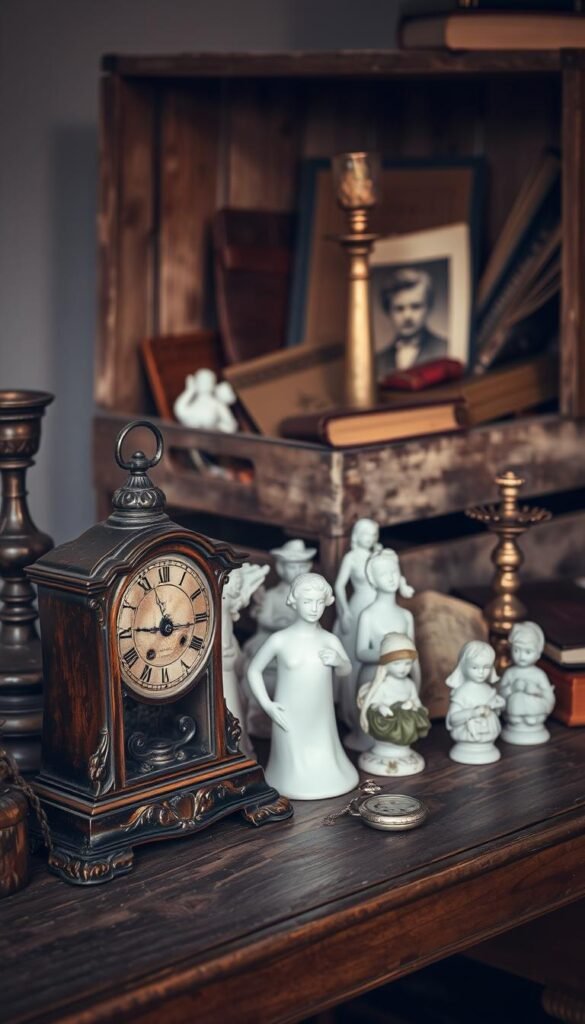
Thrift Stores and Flea Markets
Local thrift stores like Habitat ReStore offer 50% off sales on unique furniture and decor. For curated finds, explore regional hotspots like Asheboro, NC’s pottery corridor or Paris’s famed flea markets. These places are goldmines for handcrafted ceramics and timeless furniture.
Insider tip: Goodwill and Salvation Army restock mid-morning on weekdays. Arriving early increases your chances of snagging the best pieces.
Online Marketplaces and Estate Sales
Platforms like Facebook Marketplace often yield better deals than niche sites like Chairish. For high-end items, estate sales—such as the French Farmer’s Wife barn events—offer authenticated vintage collections.
Avoid common pitfalls: Always request additional photos for online purchases and verify dimensions. Pro hunters like Robyn from The French Nest recommend focusing on coastal regions for weathered, chic finds.
- Prime spots: Midwest flea markets, Southern estate sales.
- Best deals: Picker’s Festival for rare industrial pieces.
- Pro tip: Compare prices across platforms before committing.
Budget-Friendly Tips for Decorating with Vintage Finds
Transforming older items into stunning decor doesn’t have to break the bank. With a little creativity, you can achieve a unique look that blends the charm of the past with modern sensibilities. Here’s how to make the most of your thrifted treasures without overspending.
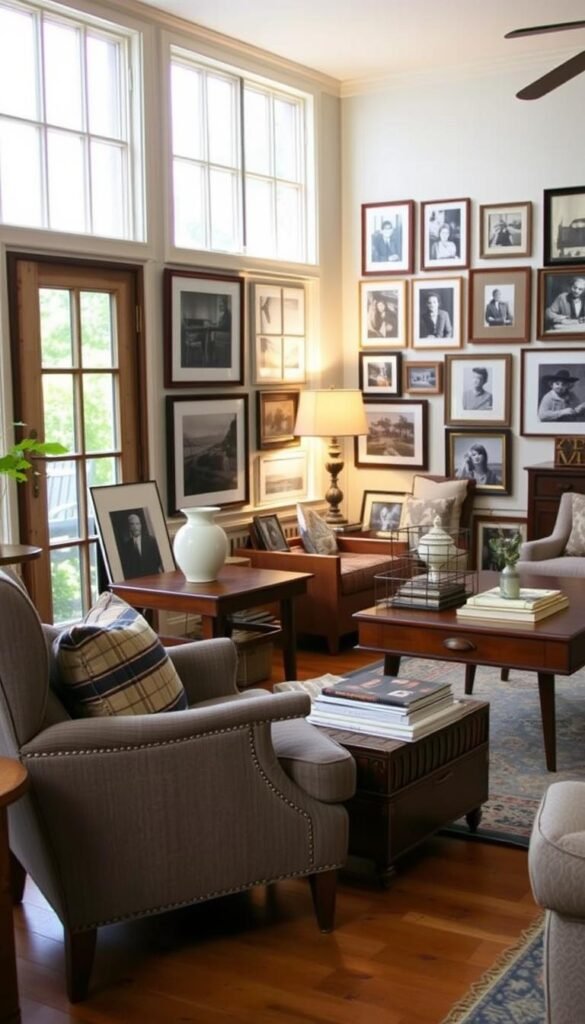
Mixing Vintage with Modern
Combining eras can create a dynamic and cohesive space. Start by using color bridging techniques to tie mismatched pieces together. For example, pair a 1970s media cabinet with contemporary accents in complementary shades. This way, you maintain harmony while celebrating the individuality of each piece.
Paint pairing formulas can also help. Neutral tones like beige or gray work well to unify diverse styles. Lora Bloomquist’s tool caddy organization solutions demonstrate how functional items can double as decor, blending practicality with aesthetics.
DIY Projects with Vintage Finds
Upcycling thrifted items is a rewarding diy project that adds personality to your home. A $5 basket can be transformed into a floral display, while a copper cauldron repurposed from a Christmas tree base becomes a unique quilt holder. These projects not only save money but also give new life to forgotten treasures.
Safety is key when restoring older items. Always test for lead paint and use proper protective gear. A restored 1970s media cabinet, for instance, can become a statement piece in your living room with a fresh coat of paint and modern hardware.
| Project | Materials Needed | Outcome |
|---|---|---|
| Floral Basket | $5 thrifted basket, faux flowers | Charming centerpiece |
| Copper Cauldron | Repurposed cauldron, quilt | Unique storage solution |
| Media Cabinet | 1970s cabinet, paint, hardware | Modernized statement piece |
By embracing these budget-friendly tips, you can create a space that feels both timeless and fresh. Whether you’re mixing styles or tackling a diy project, the possibilities are endless.
Styling Vintage Decor in Different Rooms
Bringing character to every room starts with thoughtful placement of older pieces. Whether it’s a cozy living room or a functional kitchen, vintage decor can elevate the ambiance. Here are some creative ideas to incorporate these timeless items into various spaces.
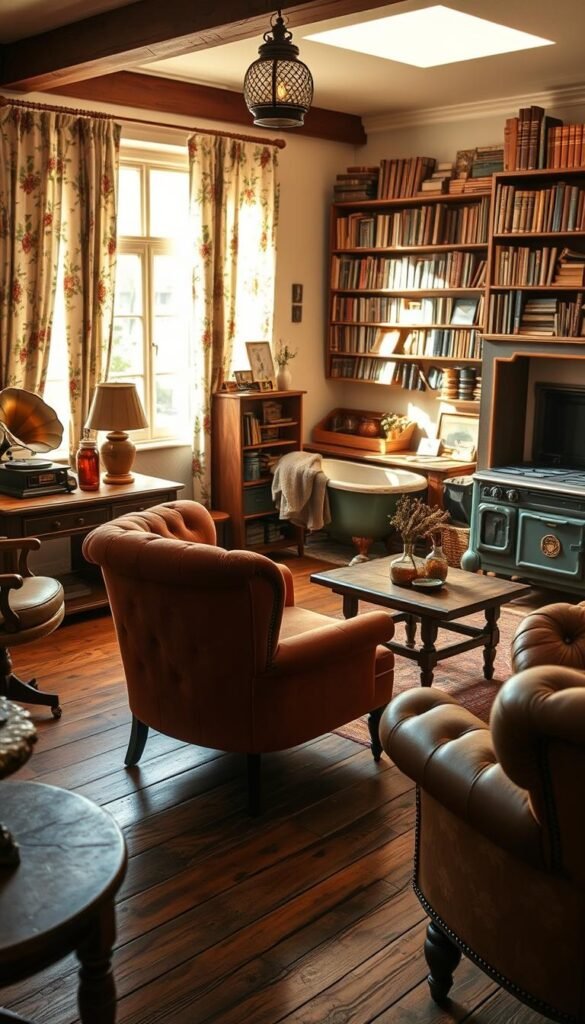
Living Room
Layering vintage rugs over hardwood floors adds warmth and texture. A patterned rug from the 1960s can anchor a seating area, while a mid-century coffee table becomes a focal point. Pair these items with modern furniture for a balanced look.
Consider adding a statement piece like a restored armchair or a retro lamp. These elements bring personality and history to the space. Mixing eras creates a dynamic yet cohesive atmosphere.
Kitchen and Dining Area
In the kitchen, integrate grain sack textiles with subway tile backsplashes for a rustic yet modern feel. A copper double-boiler displayed on the cooktop adds a touch of nostalgia. These small details make the space feel curated and inviting.
For the dining area, a walnut farm table can evolve into a stunning centerpiece. Pair it with mismatched chairs for an eclectic vibe. This combination of wood and metal creates a harmonious blend of old and new.
Bedroom
Transform your bedroom with vintage quilts hung as statement wall hangings above the bed. This idea adds color and texture while showcasing craftsmanship. A weathered dresser can serve as a functional and stylish storage solution.
Incorporate soft lighting with antique lamps or sconces. These items create a cozy and relaxing atmosphere. The bedroom becomes a sanctuary that reflects your unique style.
- Living room: Layer rugs and mix furniture styles for depth.
- Kitchen: Use textiles and copper accents for a rustic touch.
- Bedroom: Hang quilts and use antique lighting for warmth.
Incorporating Vintage Textiles and Accessories
Adding vintage textiles and accessories to your home can create a layered, timeless look. These pieces bring texture, history, and personality to any space. Whether it’s a handwoven rug or a delicate lace tablecloth, each item tells a story.
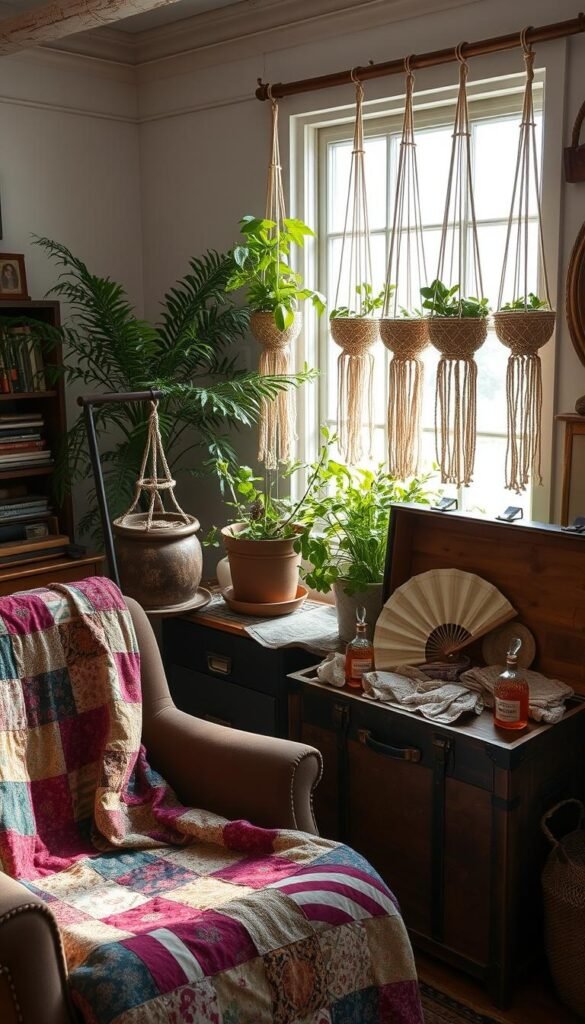
Using Vintage Textiles
Antique quilts, for example, can be displayed as wall art, adding both color and history to your room. Their intricate patterns and craftsmanship make them stand out. Tea towel pillowcases, like those from Robyn’s French Nest, are another creative way to repurpose older fabrics.
When curating textile collections, consider weight and weave compatibility. A heavy wool blanket pairs well with lighter linen curtains, creating a balanced look. Preservation is key for delicate items like lace tablecloths. Store them in acid-free tissue paper to maintain their integrity over time.
Styling Vintage Accessories
Accessories like souvenir scarves can be framed in floating glass displays, turning them into conversation pieces. For a focal point, create a wall of vintage hats, each with its own unique charm. Mixing patinas, such as brass candlesticks with ironstone pitchers, adds depth and visual interest.
These small touches can transform a room, making it feel curated and personal. For more ideas on affordable wall decor, explore creative ways to blend old and new elements.
| Textile Type | Preservation Technique | Best Use |
|---|---|---|
| Lace Tablecloths | Store in acid-free tissue paper | Dining table centerpiece |
| Antique Quilts | Hang with UV-protective glass | Wall art |
| Handwoven Rugs | Rotate every 6 months | Living room floor |
Seasonal Decorating with Vintage Finds
Seasonal changes offer a perfect opportunity to refresh your home with unique vintage pieces. By rotating older items, you can create a dynamic and inviting space that evolves with the time of year. From spring herb gardens to winter centerpieces, these ideas blend nostalgia with practicality.
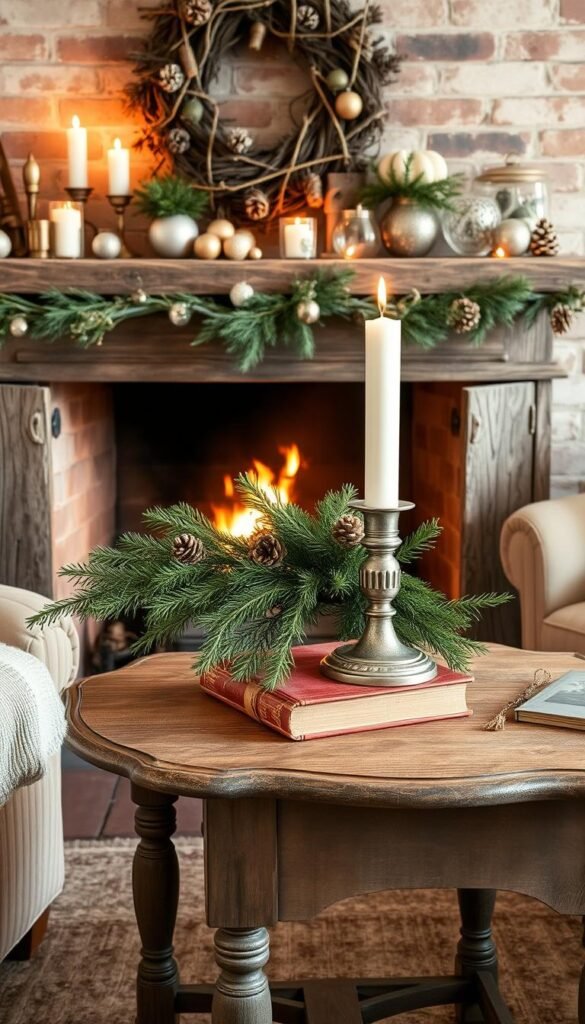
Holiday and Seasonal Themes
Each season brings its own charm, and vintage decor can enhance that. In spring, use transferware plates to create herb gardens. These plates, often found at thrift stores, add a rustic touch to your kitchen or patio.
Summer calls for enamelware picnic displays. Their durable, retro designs are perfect for outdoor gatherings. For fall, dough bowls filled with harvest-themed items like pumpkins and gourds create a cozy atmosphere.
Winter is the time for silver candelabra centerpieces. Pair them with milk glass compotes holding Shiny Brite ornaments for a festive look. These pieces, often sourced from flea markets, add elegance to your holiday table.
Rotating Vintage Decor
Rotating decor keeps your space fresh and engaging. Copper containers, for example, can transition seamlessly from summer to fall. Use them for flowers in warmer months and pinecones in cooler ones.
Storage solutions are key for delicate holiday items. Wrap ornaments in acid-free tissue paper and store them in labeled boxes. This ensures they stay pristine for years to come.
- Spring: Transferware plate herb gardens.
- Summer: Enamelware picnic displays.
- Fall: Harvest themes with dough bowls.
- Winter: Silver candelabra centerpiece strategies.
- Storage: Solutions for delicate holiday items.
For more inspiration on seasonal updates, explore these spring decor ideas. By repurposing older items, you can create a sustainable and budget-friendly home that celebrates every season.
Maintaining and Caring for Vintage Items
Caring for older items ensures their beauty and functionality endure for years. Whether it’s a cherished heirloom or a thrifted treasure, proper maintenance keeps these pieces looking their best. With the right techniques, you can preserve their charm and historical value.
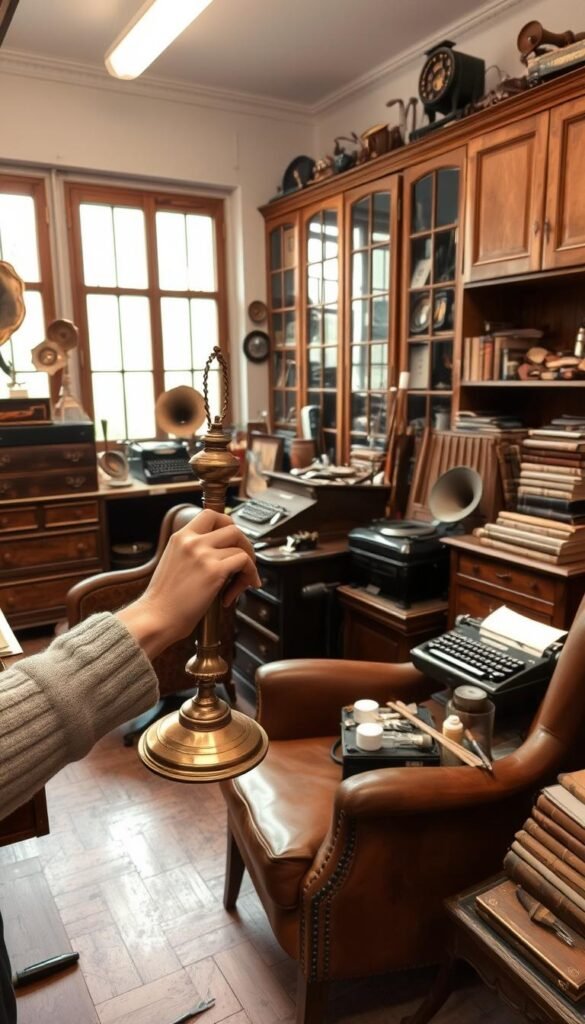
Cleaning and Restoring Vintage Finds
Restoring older items requires gentle yet effective methods. For tarnished silver, the WD-40 formula works wonders. Simply spray it on, let it sit, and wipe away the tarnish for a brilliant shine. Wooden dough bowls benefit from beeswax treatments, which nourish the wood and prevent cracking.
When tackling projects like these, always prioritize safety. For bronze fixtures, follow step-by-step patina preservation techniques to maintain their unique finish. If lead paint is present, use EPA-approved removal protocols to ensure a safe environment.
Preserving the Integrity of Vintage Pieces
Climate control is essential for delicate items like paper ephemera. Store them in a cool, dry place to prevent yellowing or damage. For larger pieces, consider professional conservation services, especially if the item holds significant historical or monetary value.
DIY restoration can be rewarding, but it’s important to know when to call in experts. Insurance appraisal documentation is also crucial for valuable items. This ensures you’re covered in case of loss or damage.
| Item Type | Care Technique | Outcome |
|---|---|---|
| Silver | WD-40 formula | Removes tarnish, restores shine |
| Wooden Dough Bowls | Beeswax treatment | Nourishes wood, prevents cracking |
| Bronze Fixtures | Patina preservation | Maintains unique finish |
By following these tips, you can keep your older items in pristine condition. Whether you’re restoring a family heirloom or a thrifted find, thoughtful care ensures their legacy lives on. For more resources, visit your local store or explore online guides that may contain affiliate links to help you earn qualifying purchases.
Conclusion
Building a home filled with character and history is a journey worth taking. From flea markets to online platforms, there are countless ways to discover unique treasures. Take your time—curating a space that reflects your personality is a gradual process, not a race.
For those seeking authenticity, resources like authentication services can help verify the value of your finds. As you explore, keep an eye on emerging trends for 2024, such as bold colors and mixed materials, to keep your space fresh and inspired.
Remember, every rescued piece diverts 18 lbs from landfills, making your efforts a great way to support sustainability. For more tips and tools, check out our curated list of resources, which may contain affiliate links or recommendations from our amazon associate partners.
Your home is a reflection of your story. Let it be one of beauty, history, and purpose.
